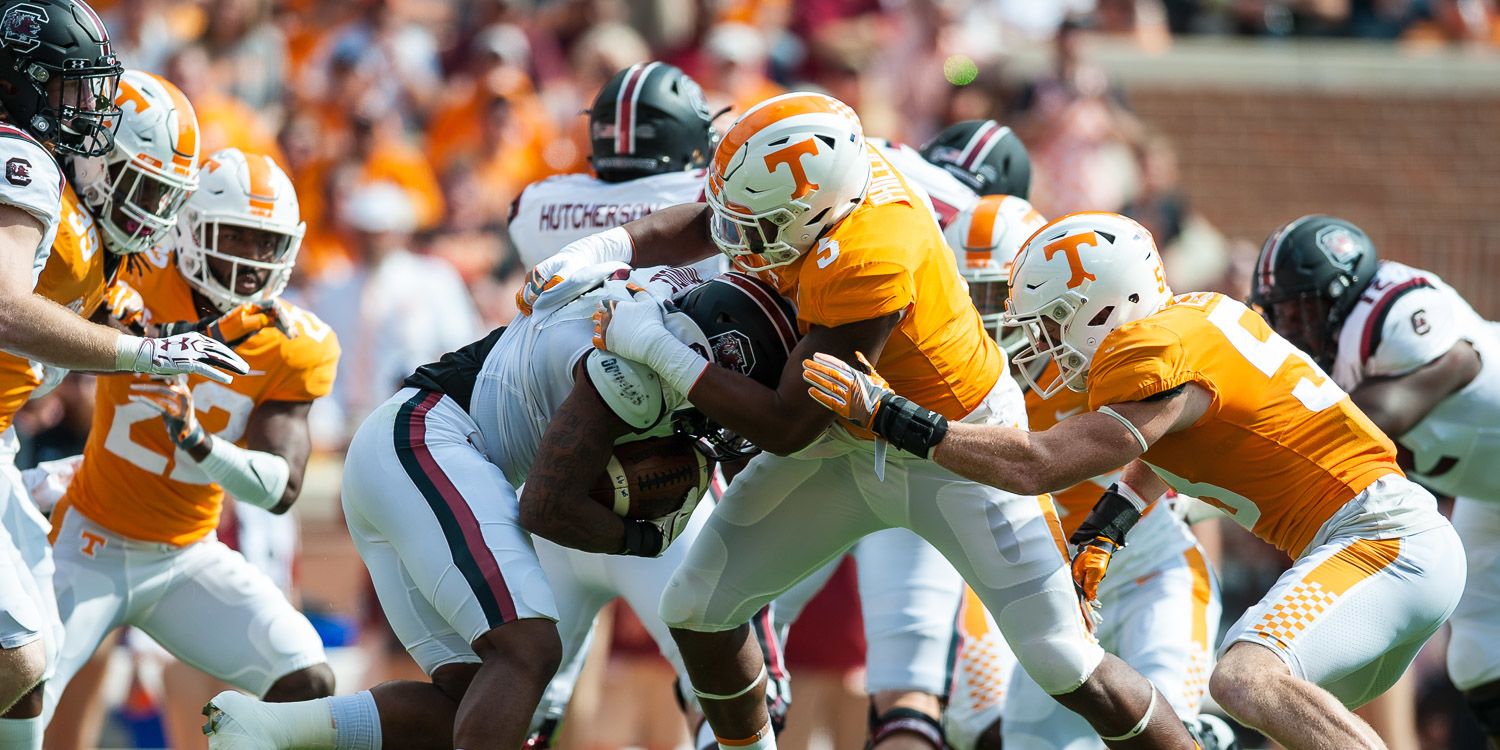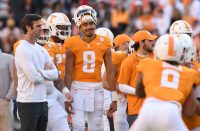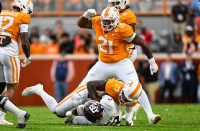There’s been a lot of talk this offseason about the current level of talent on Tennessee’s roster. Much of the reason for the discussion is borne out of the discrepancy between the recruiting rankings — Tennessee’s as a team and many of the Vols players’ individual rankings — and the actual performance on the field the past several years. The reason for the renewed interest is rooted in the hope and/or belief that the rankings weren’t as wrong as they seemed to be and that Jeremy Pruitt and his staff can finally teach the players what they need to know and coach them into their full potential on the field.
This argument has a strong gravitational pull because so many of Tennessee’s key players sported excellent rankings when they arrived on campus. If those numbers had a reasonable degree of accuracy, and if Pruitt can coach them to their potential, they should be able to hold their own against most opponents.
With Tennessee’s first depth chart of 2018 released yesterday, here’s a look at the expected talent level (and experience level) of each of Tennesse’s starters compared to that of West Virginia’s. Where the depth chart punted on a starter and bracketed more than one player into a single starting spot, we made an educated guess.
Head-to-head Tennessee-West Virginia starter chart, with recruiting rankings and current experience
Notes and observations:
- Based only on recruiting rankings, Tennessee has some degree of advantage at every level on both offense and defense.
- The biggest difference when comparing recruiting rankings comes when you compare Tennessee’s defensive line to West Virginia’s offensive line. Shy Tuttle and Kyle Phillips came to Tennessee with tremendous potential, and the Mountaineers OL were all primarily 3-star recruits.
- The smallest advantage for Tennessee in potential talent is found at the second level when Tennessee’s on offense with 3-star Vols running back Tim Jordan going against an ‘Eers linebacking corps made up of fellow 3-stars.
- If you were expecting a disadvantage in incoming talent perceptions for the Vols’ secondary compared to West Virginia’s passing attack, you’re not alone. But there’s talent in Tennessee’s secondary, with safeties Nigel Warrior and Micah Abernathy and cornerback Alontae Taylor all coming to Tennessee with four stars. West Virginia quarterback Will Grier was a high 4-star coming out of high school, but his receiving corps is made up of 3-star guys.
- That final note, of course, drives home the point that things can change once guys get to campus. To date, most of Tennessee’s players have not lived up to their potential, and the Mountaineers’ passing game has become a 5-star threat all around. Grier is a Heisman-contender. Sills was a Biletnikoff Award finalist last year. Abernathy had to fight for his starting spot this fall, and Taylor is a true freshman. Performance always trumps promise, although as Vols fans, we’d rather have promise than not.
Here’s a quick look at all of the starters this weekend, sorted by 247 Composite score, an incoming ranking:
Notes and observations:
- Tennessee’s Trey Smith is not the guy who was most-highly rated coming out of high school. That would be Mountaineers nose tackle Kenney Bigelow, a high 5-star recruit who was the nation’s ninth-best player in the Class of 2013.
- Tennessee has 18 of the 21 top-ranked players; West Virginia only 3.
Again, we believe in recruiting rankings, as it has been proven time and time again that the best college football teams in the standings at the end of the season are the same ones at the top of the recruiting standings in February. But we also know that while recruiting well is necessary to winning, it is not sufficient. The incoming talent must be developed, and at this point, you would have to concede that the West Virginia coaching staff has done a better job with their guys than the prior regime at Tennessee did with theirs.
But it does appear that the new Vols staff has the right raw material to mold, and if they are good at development, then it is not unreasonable for Vols fans to believe that the road back to relevancy might not be as long as we fear. What we see on Satrday will be the first evidence of whether we’ll be able to continue to believe in that theory for long.





Great analysis Joel… I am really pumped to see how Saturday turns out. Go Vols!!
Thanks, Harley. I can’t wait to see it, either. Hope we like what we see. 🙂
I know the Vols were unspeakably bad last year, but WVU only went 7-6.
They were 10-3 in 2016, but only 8-5 in 2015 and 7-6 in 2014; UT also won 25 games in those 3 seasons (7, 9, 9).
I believe there’s a way to stay in this game, but that may just be the preseason hopefuls talking. If we’re in the game at the start of the 4th, that would feel like a win (I mean, so would an ACTUAL win :P).
True, but they were 7-3 when Will Grier’s season ended.
I always appreciate the ranking comparisons.
Given the ambiguity of the first game starting roster I understand you had to make some guesses. But why are we guessing that 4* .9679 composite RB Ty Chandler is NOT going to be the guy?Is it just his size vs what we expect Helton to prefer?
At that point, I was mostly just going with the first name on the list, although Jordan did seem to have a good spring.
Enjoyed the post. Well written and hit on a lot of good points. Stars are important, but coaching can take you over the top. Just look at what Chris Peterson did in a short time at Washington. He took 2 stars to BCS games at Boise, and in the CFP inside of 3 years with better talent at UW. Hope we are on a similar track. Only time will tell. Pumped to have college football back in our lives. Best time of the year!
Hey, thanks for jumping in and commenting.
Agree, here’s to hoping Pruitt and his staff can develop and coach as well as they can recruit.